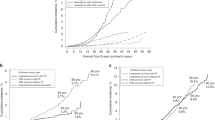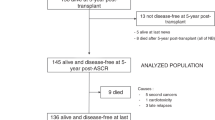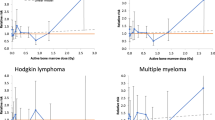Abstract
Among a cohort of 10,106 three-year survivors of childhood cancer, 90 second primary tumours (SPTs) were observed. Within 25 years of 3-year survival about 4% developed a SPT, about 6-fold expected, the relative risk not varying much with increasing follow-up. Following genetic retinoblastoma we observed 30-fold the expected number of SPTs, and over 400-fold the expected number of osteosarcomas. The risk of SPT in the absence of radiotherapy and chemotherapy (inherent risk) following genetic retinoblastoma was 13-fold expected and over 200-fold the expected number of osteosarcomas were observed. There was evidence that both radiotherapy and cyclophosphamide were associated with an increased risk of SPT. After all first primary tumours (FPTs) excluding retinoblastoma we observed almost 5-fold the expected number of SPTs. The inherent risk was 4-fold expected, the relative risks associated with radiotherapy but no chemotherapy, and both radiotherapy and chemotherapy were 6- and 9-fold expected respectively. There were about 20-fold the number of malignant bone tumours expected, most were osteosarcoma; also 7-fold the number of central nervous system tumours expected. There were 8 basal cell carcinomas and it seems likely that radiotherapy was involved in the development of some of these. Radiotherapy appears to have been involved in the development of many of the SPTs observed following all FPTs excluding retinoblastoma, particularly after CNS tumours, Wilms' tumour and Hodgkin's disease. Currently there is insufficient follow-up to examine the risk following chemotherapy. After acute leukaemia there was 20-fold the expected number of central nervous system tumours, though this is based on only 3 cases; whether therapy is directly involved in their development is uncertain. The risks we report are rarely greater than those reported in previous large-scale studies; in most instances they are substantially less. It is very unlikely that many SPTs were missed with our follow-up system so alternative explanations require further investigation; in particular it is possible the lower risks in our data compared to series treated in the United States may be explained, in part, by less combination therapy and lower doses of radiotherapy.
This is a preview of subscription content, access via your institution
Access options
Subscribe to this journal
Receive 24 print issues and online access
$259.00 per year
only $10.79 per issue
Buy this article
- Purchase on Springer Link
- Instant access to full article PDF
Prices may be subject to local taxes which are calculated during checkout
Similar content being viewed by others
Author information
Authors and Affiliations
Rights and permissions
About this article
Cite this article
Hawkins, M., Draper, G. & Kingston, J. Incidence of second primary tumours among childhood cancer survivors. Br J Cancer 56, 339–347 (1987). https://doi.org/10.1038/bjc.1987.200
Issue Date:
DOI: https://doi.org/10.1038/bjc.1987.200
This article is cited by
-
Second malignant neoplasms in lymphomas, secondary lymphomas and lymphomas in metabolic disorders/diseases
Cell & Bioscience (2022)
-
Genome-wide DNA methylation patterns reveal clinically relevant predictive and prognostic subtypes in human osteosarcoma
Communications Biology (2022)
-
Childhood cancer research in oxford III: The work of CCRG on ionising radiation
British Journal of Cancer (2018)
-
Childhood cancer research in Oxford II: The Childhood Cancer Research Group
British Journal of Cancer (2018)
-
Review of Osteosarcoma and Current Management
Rheumatology and Therapy (2016)



